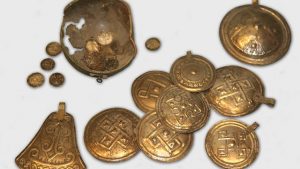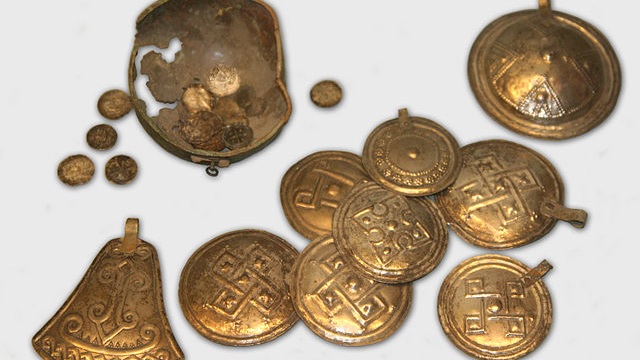This is a cross-posting of a Press Release from the American Society for Microbiology.
A team of Swiss chemists and microbiologists have shown that a species of anaerobic bacterium can inhibit corrosion on archeological artifacts made of iron. The research is published March 10 in Applied and Environmental Microbiology, a journal of the American Society for Microbiology.
In this proof-of-concept study, one strain of the anaerobic bacterium transformed the corroding surface of an iron object into the stable, iron-containing minerals, vivianite and magnetite. (Magnetite is a major component of iron ore.) Co-corresponding author Pilar Junier, PhD, Professor of Microbiology at the University of Neuchatel, Switzerland, likened the process to “flaming caramel on a dessert. You take the sugar and alcohol already at the surface and by heating it up, you get a nice crusty caramel layer.”

In more scientific terms, the bacteria transform the corrosion products of the iron by “reducing” them, which involves transferring extra electrons to the corrosion products. That causes the latter to form stable minerals. The beneficial flipside of this reaction feeds the microbes’ metabolism.
It was necessary to use an anaerobic bacterium to transform the corroding surface, since oxygen is a corroding agent. The investigators chose the Desulfitobacterium hafiense, which belongs to “a very versatile genus,” said principal investigator Edith Joseph, PhD, Assistant Professor of Heritage Chemistry, University of Neuchatel, noting that some species of this genus, including D. hafiense, were known to reduce iron. Additionally, this species is not a pathogen, an important characteristic for bacteria used in human technology.
Typically, iron objects emerge from archeological sites in bad shape, and no-where near ready for display in museums. “After excavation, changes in environmental conditions… alter the stability of the corrosion layer and can lead to total destruction of the object,” according to the report. For example, if the burial site contains chlorine, an acidic solution of iron chloride (FeCl2) is produced. After excavation, exposure to a higher oxygen concentration and/or a lower humidity level will lead to drying the iron chloride. That produces cracks in the iron, which expose the metal core to oxidation. Other reactions can also damage the objects.
The typical methods for cleaning and stabilizing iron objects are time-intensive—they can take several months—and yield toxic wastes, problems avoided by these new bacterial methods, according to the report.
These two coauthors note that theirs is an interdisciplinary collaboration, combining Joseph’s background in conservation science with Junier’s microbiology background. Joseph collaborates with many museums and cultural heritage institutions, which bring problems such as corrosion on ancient iron to her attention, and Junier’s knowledge of microbial metabolic processes enables her to determine candidate bacteria for various preservation-related jobs. (Microbes, it should be noted, are a huge source of potentially useful chemistry, said Joseph.)
The earliest known iron objects were produced in 1,380 BC in the Hittite empire, which encompassed much of what is now Turkey, and some of modern day Syria.
# # #
The American Society for Microbiology is the largest single life science society, composed of over 48,000 scientists and health professionals. ASM’s mission is to promote and advance the microbial sciences.
ASM advances the microbial sciences through conferences, publications, certifications and educational opportunities. It enhances laboratory capacity around the globe through training and resources. It provides a network for scientists in academia, industry and clinical settings. Additionally, ASM promotes a deeper understanding of the microbial sciences to diverse audiences.
